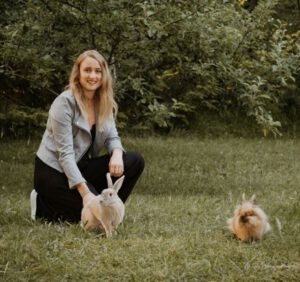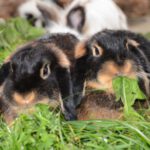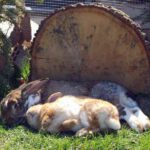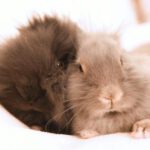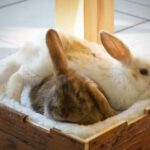Contents
- Why are there so many poorly socialized rabbits?
- Examples of aggressive behavior in rabbits:
- The socialization behavior is learned during the socialization phase.
- How is social behavior learned during puberty?
- Social behavior can still be learned later, but aggression remains lifelong.
- How does a lack of socialization manifest in affected rabbits?
- Origin Makes the Difference
- Warning: „Neutering Quarantine“
- When can baby rabbits be separated from their mother?
- Socialization with Humans

Many rabbit owners eventually wonder why some rabbits are not suitable for groups (and can only be kept as a pair), why biting occurs repeatedly, and why the group doesn’t simply harmonize.
Unfortunately, those who keep groups of rabbits know that some rabbits are not suited for group living and can only be kept in pairs. As soon as a same-sex rabbit appears, they become very aggressive. This happens even though rabbits naturally live in groups and are highly social animals.
Examples of aggressive behavior in rabbits:

How can this be?
There is a simple explanation for this. Rabbits have a strict hierarchy among males and among females, but the hierarchy between genders is either loose or non-existent. This is why bonding with the opposite sex is much easier. Once a group is formed, the rabbits need to be well-socialized in order to establish a hierarchy without causing serious injury.
Unfortunately, very few rabbits are able to do this.
Our rabbits almost always grow up alone with the mother (and not in a group). They miss out on the group dynamic with adult bucks and does, as these older rabbits would help raise and socialize the young ones. This does not happen. Additionally, the young rabbits are almost always separated from the mother too early. Ideally, they should stay with the mother until at least 10 weeks, but usually, they are separated at 5–8 weeks and never get the chance to learn social behavior from her.

Social behavior is not fully innate; it is learned.
„Even if animals belong to the same species, there are significant differences in how they respond to environmental challenges. Factors such as age, gender, and genetic predisposition, but especially experiences during development, are responsible for these differences. Research on rhesus monkeys in the 1950s first demonstrated the influence of socialization conditions on the later behavior of animals: Unlike monkeys that grew up in social groups, those raised alone in isolation reacted to new situations with fear and depression, while being hyperaggressive toward unfamiliar conspecifics. They could no longer form ’normal‘ social relationships within their species.
However, these findings are not limited to primates. It is likely that all mammals require proper socialization conditions in order to communicate and interact successfully with conspecifics.“
Ach, J. S., & Stephany, M. (2010): Die Frage nach dem Tier. Interdisziplinäre Perspektiven auf das Mensch-Tier-Verhältnis, Münster: LIT Verlag.
„Social experiences during ontogeny not only affect the behavior of adult animals but also their physiological stress responses, as we demonstrated in our studies on guinea pigs. When male guinea pigs grow up in mixed-sex colonies, they integrate into new colonies without problems as adults. On the first day, they explore the unfamiliar environment but do not show any overtly aggressive behavior towards resident males or courtship behavior towards females. Within the following days, they integrate into the social structure of the new group without noticeable threatening or fighting behavior. As shown in Figure 3, males raised in colonies do not show changes in their stress hormone concentrations when placed in a new situation.

However, animals raised alone or in pairs (i.e., with a female) behave quite differently in the same situation: As soon as they encounter a strange female, they display intense courtship behavior. When they meet a strange male, they attack. They are eventually defeated by the resident males and retreat to a corner of the colony. Although they are no longer involved in interactions, strong physiological stress responses occur. Just five hours after being moved to a new colony, their cortisol concentrations increase by nearly 200%, and by the third day of the trial, their body weight decreases by about 10%. It takes twenty days after being integrated into the new social group for their hormone levels to return to normal.“
Ach, J. S., & Stephany, M. (2010): Die Frage nach dem Tier. Interdisziplinäre Perspektiven auf das Mensch-Tier-Verhältnis, Münster: LIT Verlag.
„How do these differences arise? When young males grow up in colonies, they become involved in aggressive encounters with older, dominant males during puberty. In these interactions, they experience the role of a subordinate individual and acquire the social skills needed to manage interactions with conspecifics with minimal stress and aggression. Interestingly, these skills are not, as was previously believed, instinctively present. However, when a male grows up alone or in pairs, that is, with a female, he does not engage in aggressive interactions with conspecifics during puberty. As a result, he will not learn the essential social skills. The consequence is escalated aggressive behavior and strong hormonal stress reactions when encountering conspecifics, without having learned how to manage these interactions.“

Ach, J. S., & Stephany, M. (2010): Die Frage nach dem Tier. Interdisziplinäre Perspektiven auf das Mensch-Tier-Verhältnis, Münster: LIT Verlag.
Close cages, pens, and early isolation of babies do not promote their social and play behavior, but rather their frustration, which inevitably leads to aggression. Although social behavior can still be learned later, rabbits raised in poor conditions remain more aggressive than those raised in better environments.
Social behavior can still be learned later, but aggression remains lifelong.
„For example, researchers led by Áron Tulogdi from the Budapest Institute of Experimental Medicine demonstrated this in the journal Developmental Psychobiology (online). The researchers attempted to make aggressive rats more peaceful. These naturally social animals become aggressive when they are isolated during early childhood. Can this misimprinting be undone by group housing? To clarify this, the scientists initially placed three-week-old rat pups in solitary confinement. The results left a mark: The animals raised in isolation were later aggressive, reacted fearfully to their cage mates, and slept separately from them. The researchers saw similarities with humans who experience traumatic events in childhood.
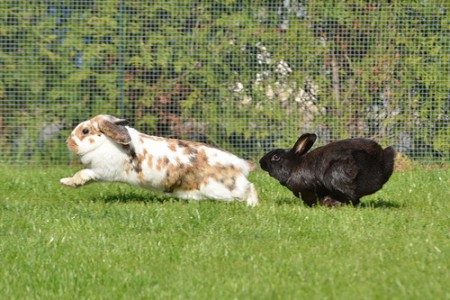
However, within a few days in a group setting, the behavior of the isolated rats changed. Soon, they were sleeping with the other animals. However, they remained more aggressive than rats that had been normally socialized. In terms of group behavior, the rats could be resocialized, but when it came to their aggression, they could not, the researchers concluded. The aggressiveness had become part of their character. Again, the scientists recognized remarkable parallels: While social phobias in humans can often be successfully treated, treating aggressive behavior is much more difficult.“
Habich, I. (2014): Mensch, Kaninchen. Süddeutsche Zeitung. [http://www.sueddeutsche.de/wissen/verhaltensbiologie-mensch-kaninchen-1.2107018, 29.09.2017]
„Encounters between two animals raised in this way generally have to be interrupted, as otherwise, it would lead to severe health damage, even to the point of death. Our findings point to the puberty phase as the critical period in an animal’s life when the essential social skills for cohabitation are acquired. Clearly, there exists a causal relationship between the social experiences animals have during puberty, their aggressive behavior, and the extent of hormonal stress reactions when encountering unfamiliar conspecifics.“
Ach, J. S., & Stephany, M. (2010): Die Frage nach dem Tier. Interdisziplinäre Perspektiven auf das Mensch-Tier-Verhältnis, Münster: LIT Verlag.
Origin Makes the Difference
Buying rabbits from pet stores (where they come from mass breeding operations) or from breeders who do not raise them in groups supports breeding conditions that inevitably lead to aggression. Raising rabbits in cages or stalls with occasional free-roaming time, rather than in larger groups, is just as harmful as prematurely selling them while they are still small and cute. Such purchases promote a developmental path that makes it extremely difficult for rabbits to live in groups.
Warning: „Neutering Quarantine“
As shown in the quotes above, even a few weeks of solitary confinement during the socialization phase can leave lasting damage. A solution to this is early neutering (before sexual maturity, i.e., before 12 weeks of age). This allows young rabbits to grow up in a group setting with both older and younger rabbits without being separated.
When can baby rabbits be separated from their mother?
Do not separate baby rabbits from their mother too early (never before 12 weeks of age, ideally 14-16 weeks) for the following reasons:
- Observations clearly show that rabbits nurse much longer than just the 6th or 8th week of life. Since this usually happens only at night, most breeders don’t notice it. Baby rabbits need their mother’s milk to develop a healthy immune system. If they are abruptly weaned, this process is often disrupted.
- The first four months are the most important socialization phase for rabbits. During this time, they learn social behaviors in a group setting with adult rabbits and siblings. A harmonious, stable group with adult rabbits of different sexes is necessary for this. Animals raised alone or with only one other rabbit during this period will develop poor social behavior and may not be as compatible with other rabbits later on.
- The babies play and cuddle intensely with each other in the first few weeks. The contact with an adult rabbit can never replace these interactions. This is similar to a human child growing up without interaction with peers.
- During this time, the gut flora and immune system are being developed. Moving the rabbit to a new owner (or even to a pet store), changing their diet, and introducing them to new rabbits expose them to new germs and stress them unnecessarily. This can cause some rabbits to suffer from immune deficiencies later in life.
- The babies also consume the mother’s cecotropes, which help them build their gut flora. This is only possible if they stay with their mother until at least 16 weeks.
- When young rabbits are introduced to new homes, it is ideal for them to be placed with same-sex adult rabbits. This helps them learn social behavior and how to be subordinate in a group, making them less aggressive later on. Young rabbits are not ideal for beginners; it’s better to adopt a fully grown, harmonious pair and introduce young rabbits later.
Socialization with Humans

Baby rabbits can become very tame if they are accustomed to close, loving contact with humans from the start. To achieve this, you should spend some time each day during nest checks gently petting the babies, allowing them to get used to human hands. This will help them become very tame later on. It is important to handle them gently and provide regular, loving, and consistent contact.
Studies show that even the first contact during their first week of life has a significant impact on whether the rabbits will be tame later. Even a piece of clothing with a human scent or a five-minute contact session close to feeding time is enough to begin familiarizing them with humans. Since rabbits typically nurse in the early morning hours, nest checks with human contact in the morning are ideal.
Additionally, there is a sensitive period between the first and sixth week of life when baby rabbits should have as many positive experiences with humans as possible.
High-quality breeders, shelters, and rescue centers follow this approach and socialize the animals to humans. This leads to more relaxed handling of the house rabbits in daily life, including during medical procedures.
Sources, including
Ach, J. S., & Stephany, M. (2010): Die Frage nach dem Tier. Interdisziplinäre Perspektiven auf das Mensch-Tier-Verhältnis, Münster: LIT Verlag.
Csatadi K, Kustos K, Eiben Cs, Bilko A, Altbäcker V.(2005): Even minimal human contact linked to nursing reduces fear responses toward humans in rabbits. Appl Anim Behav Sci. 95:123–8. 11.
Csatadi K, Bilko A, Altbäcker V. (2007): Specificity of early handling: Are rabbit pups able to distinguish between people? Appl Anim Behav Sci. 107:322–7 12.
Ducs A, Bilko A, Altbäcker V. (2009): Physical contact while handling is not necessary to reduce fearfulness in the rabbit. Appl Anim Behav Sci. 121:51-4.
Habich, i. (2014): Mensch, Kaninchen. Süddütsche Zeitung. [http://www.sueddeutsche.de/wissen/verhaltensbiologie-mensch-kaninchen-1.2107018, 29.09.2017]
Rödel, H. G., & Monclús, R. (2011): Long-term consequences of early development on personality traits: a study in European rabbits. Behavioral Ecology, 22(5), 1123-1130.


